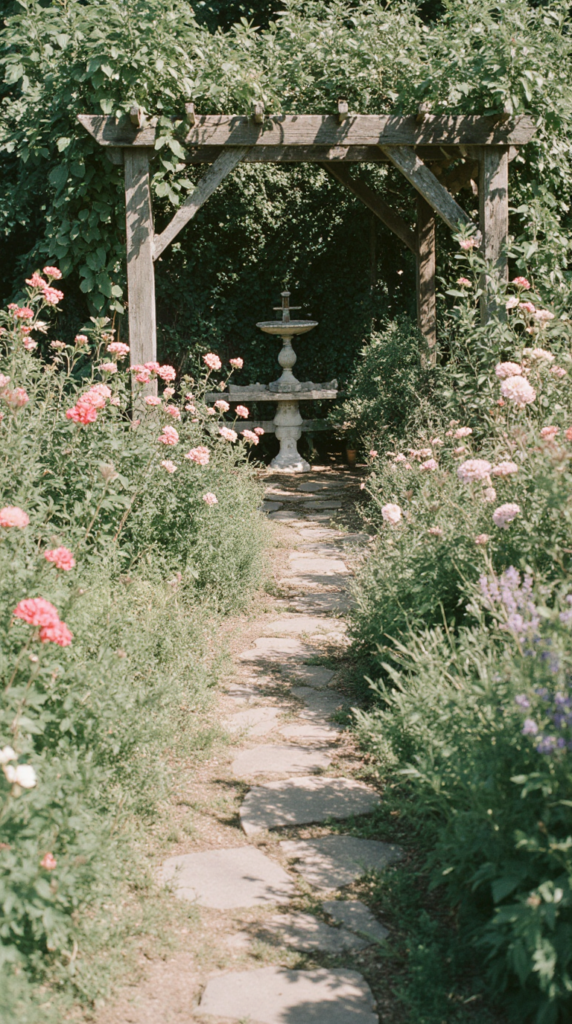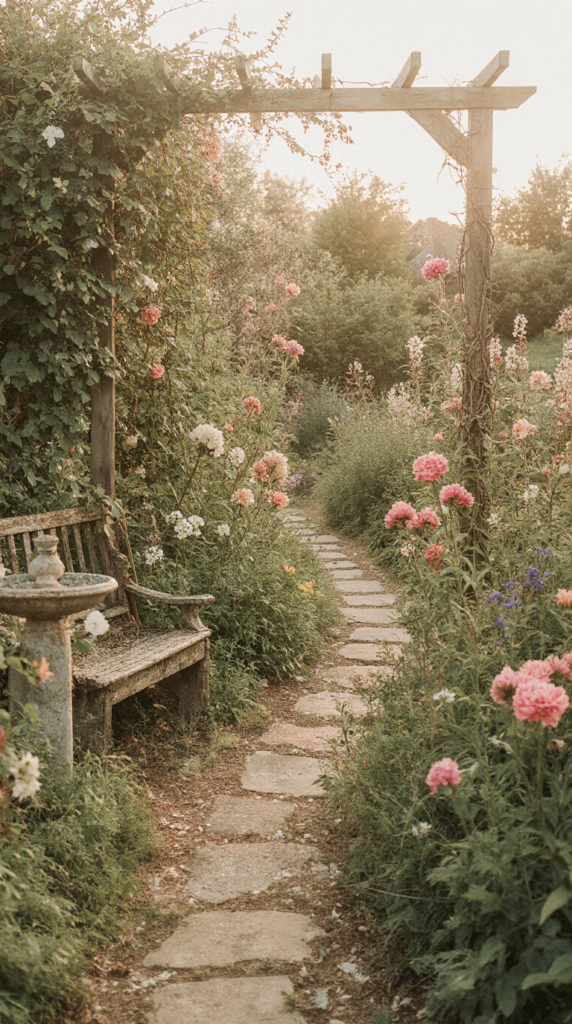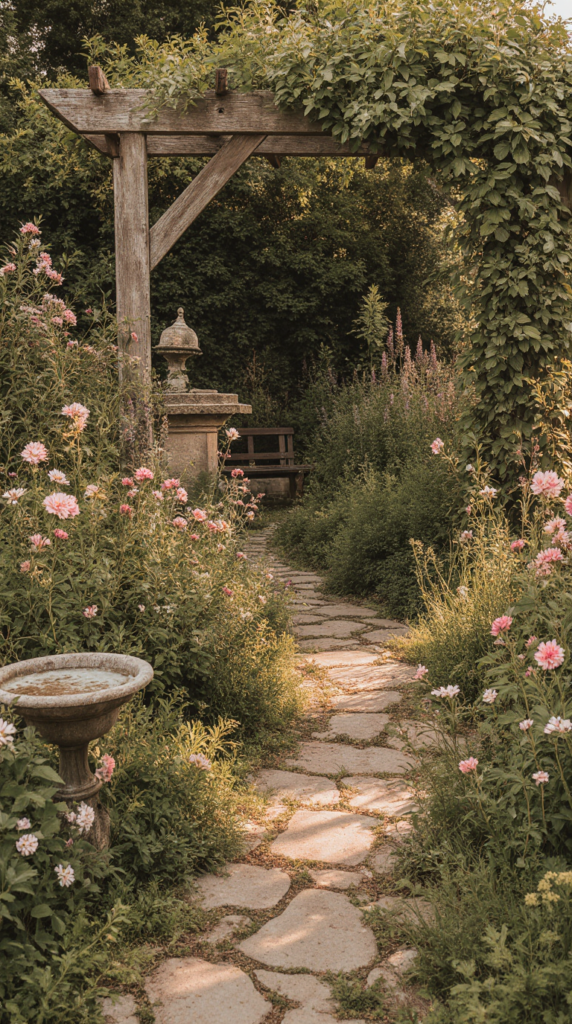There’s something undeniably magical about a cottage garden. Perhaps it’s the way the morning light filters through the tangled roses, or how the gentle chaos of blooms seems perfectly orchestrated by nature itself. My own journey with cottage gardening began when I inherited my grandmother’s country home—complete with a neglected but promising garden space that whispered of possibilities. That forgotten patch has since become my sanctuary, a place where structured design meets wild abandon, and where every season brings new delights.
Cottage gardens invite us to step away from the rigid lines of modern landscaping and embrace a style that celebrates abundance, whimsy, and personal expression. They tell stories of generations past while creating new memories with every bloom and stone path. Whether you have acres to work with or just a small urban plot, the cottage garden style can transform your outdoor space into a haven of fragrance, color, and life.
In this comprehensive guide, we’ll explore 36 enchanting cottage garden ideas that can help you create your own storybook landscape—one that reflects your personality while honoring this timeless gardening tradition.
Table of Contents
What Defines a Cottage Garden?
Before diving into specific ideas, let’s understand what makes a cottage garden distinctive. Unlike formal gardens with their precise geometry and restrained plantings, cottage gardens embrace:
- Abundant plantings with flowers, herbs, and vegetables growing together
- Informal design that appears casually arranged yet thoughtfully composed
- Traditional plant varieties including old-fashioned perennials and heirloom vegetables
- Vertical elements like climbing roses, arbors, and trellises
- Personal touches that reflect the gardener’s personality and preferences
- Year-round interest through succession planting and structural elements
The cottage garden style originated centuries ago in England, where rural homeowners maximized small spaces by intermingling ornamentals with edibles. Today, this approach has evolved into a beloved aesthetic that gardeners worldwide adapt to their own climate and tastes.
Planning Your Cottage Garden: Foundational Elements
1. Create Garden Rooms with Natural Divisions
Divide your cottage garden into distinct “rooms” using hedges, arbors, or changes in elevation. This creates a sense of journey and discovery as visitors move through your garden.
Expert Tip: Boxwood hedges offer structure year-round while flowering hedges like lavender provide seasonal interest.
2. Establish Meandering Pathways
Curved paths invite exploration and enhance the whimsical feel of a cottage garden. Materials should feel natural and weathered.
Pathway Materials to Consider:
- Flagstone or slate
- Gravel with stone borders
- Brick laid in herringbone pattern
- Stepping stones with thyme growing between

3. Design with Year-Round Structure in Mind
While seasonal blooms create the signature cottage garden look, structural elements ensure your garden remains attractive throughout the year.
| Structural Element | Benefits | Example Varieties |
|---|---|---|
| Dwarf shrubs | Year-round presence, framework for perennials | Boxwood, dwarf conifers, small hydrangeas |
| Ornamental grasses | Winter interest, movement | Miscanthus, Festuca, Carex |
| Climbing structures | Vertical interest, space maximization | Wooden obelisks, arbors, weathered trellises |
| Stone elements | Permanence, weathered aesthetic | Bird baths, benches, wall fragments |
4. Plan for Succession Planting
A true cottage garden offers continuous blooms from early spring through late autumn. Plan your plantings to ensure something is always coming into flower as other plants fade.
Classic Cottage Garden Plants
5. Incorporate Traditional Flowering Perennials
The backbone of any cottage garden is a rich tapestry of classic perennial flowers that return year after year.
Must-Have Cottage Garden Perennials:
- Delphinium for vertical drama
- Hollyhocks alongside fences and walls
- Foxgloves for dappled shade areas
- Peonies for fragrance and cutting
- Dianthus for edging and fragrance
- Lavender for structure and scent
- Daisies for simple charm
- Yarrow for drought tolerance
6. Add Self-Seeding Annuals for Spontaneity
Part of the cottage garden charm comes from plants that appear in unexpected places through self-seeding.
Reliable Self-Seeders:
- Forget-me-nots
- Nigella (Love-in-a-mist)
- Calendula
- Borage
- Poppies
- Sweet alyssum
- Cosmos
- Larkspur
7. Integrate Climbing and Rambling Roses
No cottage garden is complete without roses scrambling over structures, releasing their perfume on summer evenings.
Cottage Rose Varieties:
- ‘Zéphirine Drouhin’ (thornless climber with raspberry-pink blooms)
- ‘Constance Spry’ (once-blooming with exceptional fragrance)
- ‘The Generous Gardener’ (repeat-flowering English rose)
- ‘New Dawn’ (disease-resistant climber with soft pink blooms)
8. Blend in Edibles
Historically, cottage gardens combined beauty with practicality by incorporating vegetables, herbs, and fruit.
Ornamental Edibles for Cottage Gardens:
- Rainbow chard
- Purple sage
- Bronze fennel
- Artichokes
- Alpine strawberries
- Blueberry bushes (also provide fall color)
- Decorative cabbages
Creating Vertical Interest
9. Install Arbors and Arches
These structures create garden focal points while supporting climbing plants.

10. Use Obelisks as Plant Supports
Obelisks provide architectural interest while supporting climbing plants like clematis or sweet peas.
11. Incorporate a Rustic Trellis
A weathered wooden trellis against a wall or fence creates the perfect support for climbing roses or morning glories.
12. Try a Tuteur for Vertical Accent
These pyramid-shaped structures add height to garden beds while supporting vining plants.
Hardscaping and Structural Elements
13. Add Vintage Garden Gates
A weathered garden gate suggests there’s something special beyond, even when used as a purely decorative element.
14. Include a Rustic Bench or Two
Seating invites visitors to linger and appreciate the garden from different perspectives.
15. Incorporate Stone Walls or Raised Beds
Dry-stacked stone walls or mortared stone raised beds add permanent structure while providing habitat for beneficial insects.
Construction Tip: Allow some planting pockets in walls for rock garden plants like sedums and sempervivums.
16. Install a Quaint Bird Bath
Bird baths attract wildlife while serving as garden focal points.
Whimsical Cottage Garden Accents
17. Display Vintage Garden Tools
Mount antique garden tools on a fence or shed wall for nostalgic charm.
18. Add Garden Ornaments with Character
Look for weathered or moss-covered ornaments that appear to have been in the garden for generations.
Ideas for Garden Ornaments:
- Stone animals partially hidden among plants
- Aged sundials
- Concrete mushrooms
- Antique watering cans
- Weather-worn statuary
19. Hang Wind Chimes for Sensory Appeal
The gentle tinkling of wind chimes adds an auditory dimension to your garden experience.
20. Create Plant Collections in Vintage Containers
Group collections of plants in weathered terracotta pots, galvanized buckets, or repurposed household items.
Cottage Garden Design Styles
21. Traditional English Cottage Garden
Emphasize old-fashioned roses, foxgloves, and lamb’s ear for that quintessential English garden feel.
22. Herb-Focused Cottage Garden
Create a garden centered around culinary and medicinal herbs, with lavender, thyme, and sage taking center stage.
| Herb Type | Garden Use | Cottage Garden Varieties |
|---|---|---|
| Culinary | Cooking, teas | Rosemary, thyme, sage, mint |
| Medicinal | Traditional remedies | Echinacea, valerian, chamomile |
| Fragrant | Scent, cutting | Lavender, lemon balm, scented geraniums |
| Ornamental | Visual appeal | Purple sage, bronze fennel, variegated thymes |
23. Modern Cottage Garden
Update the cottage garden style with contemporary elements like ornamental grasses and simplified color schemes.
24. Drought-Tolerant Cottage Garden
Adapt the cottage garden aesthetic for dry climates using Mediterranean herbs, native wildflowers, and water-wise roses.
Small-Space Cottage Garden Ideas
25. Create a Container Cottage Garden
Even a balcony or small patio can capture cottage garden charm with the right plant selection and container groupings.
26. Design a Cottage Garden Entryway
Transform your front entry with cottage garden elements like climbing roses over the door and lavender lining the path.
27. Develop a Cottage Window Box
Window boxes planted with trailing nasturtiums, compact herbs, and seasonal flowers bring cottage charm to any home exterior.
28. Plan a Cottage-Style Cutting Garden
Dedicate a small sunny area to cutting flowers like zinnias, cosmos, and snapdragons for indoor arrangements.
Seasonal Considerations
29. Plant for Spring Bulb Displays
Naturalize daffodils, tulips, and grape hyacinths throughout your cottage garden for early-season color.
30. Ensure Summer-Long Blooms
Plan for continuous summer color with succession planting of classics like phlox, coneflowers, and Shasta daisies.
31. Include Fall-Blooming Perennials
Extended the season with autumn stars like asters, Japanese anemones, and sedums.
32. Add Winter Interest Elements
Incorporate evergreens, ornamental grasses, and plants with attractive seed heads for winter structure.
Practical Cottage Garden Tips
33. Embrace Controlled Chaos
Allow some self-seeding and plant spreading for that authentic cottage garden feel.
34. Implement Companion Planting
Use traditional companion planting techniques to reduce pests and enhance growth naturally.
Companion Planting Examples:
- Roses with garlic to deter aphids
- Nasturtiums to draw aphids away from vegetables
- Marigolds near tomatoes to repel nematodes
- Borage near strawberries to attract pollinators

35. Attract Beneficial Wildlife
Install bird houses, pollinator hotels, and frog habitats to create a balanced garden ecosystem.
36. Practice Sustainable Garden Management
Embrace organic methods, water conservation, and composting to align with the self-sufficient heritage of cottage gardens.
Creating Your Own Cottage Garden Story
The beauty of cottage gardening lies in its personal nature. Your garden should reflect your preferences, memories, and local growing conditions. Start small, perhaps with a corner of your yard devoted to this style, and allow it to evolve naturally over time.
Remember that the most charming cottage gardens are those that develop gradually, with plants that clearly feel at home and elements that weather gracefully. As you implement these ideas, your garden will develop its own unique character—becoming not just a collection of plants, but a living expression of your gardening journey.
A true cottage garden isn’t created in a season; it matures and improves with age, telling the story of its caretaker through every bloom, meandering path, and weathered garden ornament.
For more gardening tips follow us on Pinterest
FAQs About Cottage Gardens
What makes a garden a cottage garden?
A cottage garden features informal, densely planted flower beds with a mixture of ornamental and edible plants, typically including traditional flowers like roses, foxgloves, and hollyhocks, along with herbs and vegetables. The design appears casually arranged yet abundant, often incorporating rustic pathways and vintage elements.
Can I create a cottage garden in a small space?
Absolutely! The cottage garden style can be adapted to any size space. In small areas, focus on vertical elements like trellises, select multi-purpose plants, and use containers strategically. Even a window box or tiny courtyard can capture cottage garden charm with the right plant selection and styling.
How do I maintain a cottage garden without it looking messy?
The secret is implementing “structured chaos”—use permanent elements like paths, small hedges, or edging to create frameworks that contain the exuberant plantings. Regular deadheading, dividing overgrown perennials, and thoughtful pruning help maintain the balance between whimsy and tidiness in a cottage garden.
Which plants are essential for starting a cottage garden?
Start with a foundation of perennials like roses, lavender, delphinium, and foxgloves, then add self-seeding annuals such as cosmos and nigella. Include structural elements like small shrubs or ornamental grasses, and don’t forget climbing plants to add vertical interest. Choose varieties that suit your climate for best results.
How do I plan a cottage garden that blooms throughout the seasons?
Plan for succession planting by selecting plants with different bloom times. Include spring bulbs, early-summer perennials, late-summer bloomers, and fall-flowering plants like asters. Add evergreen shrubs and plants with interesting seed heads or winter structure to maintain year-round interest in your cottage garden.
What is the 70/30 rule in gardening?
The 70/30 rule suggests planting 70% reliable, easy-care plants that provide structure and repeat blooming, and 30% more unique, seasonal, or experimental varieties. This balance ensures visual interest without overwhelming maintenance.
Are cottage gardens hard to maintain?
While cottage gardens appear wild and effortless, they do require regular upkeep. Tasks include deadheading flowers, weeding, pruning, and managing plant spread. However, choosing hardy, low-maintenance plants can make care much easier over time.
What is the difference between an English garden and a cottage garden?
An English garden often refers to a formal landscape design with manicured lawns, clipped hedges, and symmetrical layouts. In contrast, a cottage garden is informal, densely packed with flowers, and focused on charm over order.
What plants do you put in a cottage garden?
Classic cottage garden plants include hollyhocks, foxgloves, roses, delphiniums, lavender, daisies, and sweet peas. Herbs like thyme and rosemary, along with flowering climbers like clematis or wisteria, are also common choices.
